Captivated Beneath the Surface: Liveaboard Diving Holidays in the Galapagos Islands
Dive into the depths where evolution's legends lie, amidst hammerhead sharks and manta rays. Known as the Enchanted Isles, the Galapagos Islands are a diver’s paradise for liveaboard adventures in a unique marine ecosystem. Celebrated for rich biodiversity, both above and below water, they offer unmatched diving. A liveaboard grants access to remote dive spots teeming with vibrant sea life at sites like Gordon Rocks, Wolf, and Darwin, each offering unique underwater marvels. This article highlights the top dive sites, extraordinary marine encounters, and the best times to visit, along with essential planning tips for an unforgettable trip to these magical isles.
Diving Highlights
- Drift alongside hundreds of scalloped hammerhead sharks at Darwin’s Arch and Wolf Island.
- Witness whale sharks (June–November) gliding through the northern archipelago’s nutrient-rich currents.
- Explore volcanic tunnels and “Champagne bubbles” at Roca Redonda, teeming with reef sharks and barracuda.
- Dive with Galapagos penguins at Bartolomé Island—the only penguins found on the equator.
- Navigate the swirling currents of Gordon Rocks, nicknamed “The Washing Machine” for its adrenaline-pumping dive
Marine Animal Highlights
- Galapagos Shark (Carcharhinus galapagensis): Bold reef predators often seen patrolling rocky outcrops at Gordon Rocks and Wolf Island.
- Marine Iguanas (Amblyrhynchus cristatus): The world’s only seafaring lizards, grazing algae underwater near Fernandina Island.
- Oceanic Manta Rays (Mobula birostris): Graceful giants cleaning at coral-covered sites like Cousins Rock.
- Galapagos Sea Lions (Zalophus wollebaeki): Playful pups twirling around divers at shallow reefs like Mosquera.
- Mola Mola (Mola mola): Oddball ocean sunfish feeding in cold upwellings (July–December).
- Whale Sharks (Rhincodon typus): Gentle giants (June–November) cruising Wolf and Darwin’s currents, often alongside hammerheads
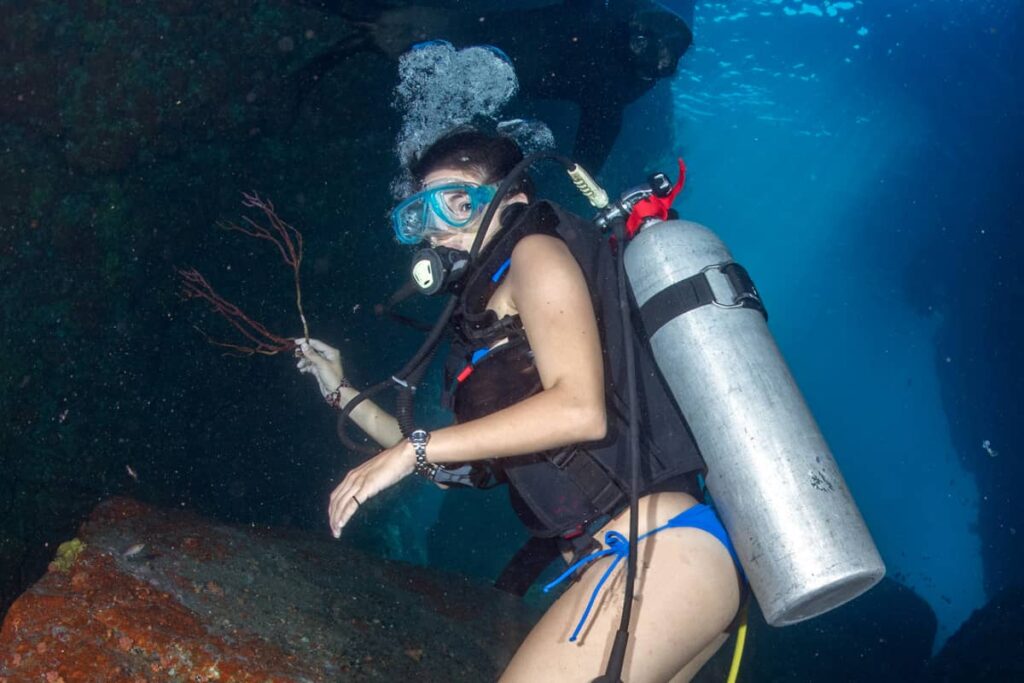
Why Choose Liveaboard Diving in the Galapagos?
Liveaboard diving in the Galapagos offers a diving experience like no other. The islands boast some of the world's most stunning marine environments.
Unique Marine Ecosystems
The Galapagos Islands are a sanctuary of rich and varied marine life. Situated where warm and cold currents meet, the islands enjoy a unique environment that allows diverse species to thrive. This includes creatures like Galapagos sea lions, marine iguanas, and rays. Many species found here are endemic, meaning they exist only in these waters. Around Darwin and Wolf Islands, marine sanctuaries protect this biodiversity, ensuring these unique ecosystems remain vibrant. Rich ocean currents provide nutrients, drawing in sea life such as the curious Mola mola and Galapagos penguins. These factors combine to make the Galapagos an exceptional diving destination.
Access to Remote Dive Sites
One exceptional benefit of a Galapagos liveaboard diving cruise is access to sites that are otherwise hard to reach. Liveaboards transport divers directly to remote locations teeming with marine life, saving time that would be spent traveling from ports. These distant dive spots often feature stronger currents and waves, suiting more experienced divers seeking adventure. Diving directly from the boat allows for immediate immersion in pristine waters, elevating the thrill and discovery of the diving adventure.
Benefits of a Liveaboard Experience
Liveaboard diving cruises in the Galapagos provide tailored experiences that reach the furthest corners of the islands. These cruises follow strict routes regulated by the government, serving both conservation and exploration purposes. Typically, itineraries include limits to two land excursions, ensuring the islands' beauty remains unspoiled.The journey aboard a liveaboard is not just about diving; it offers comfort with extensive amenities, guided by world-class dive leaders. This combination allows divers to fully engage with the stunning underwater landscapes.
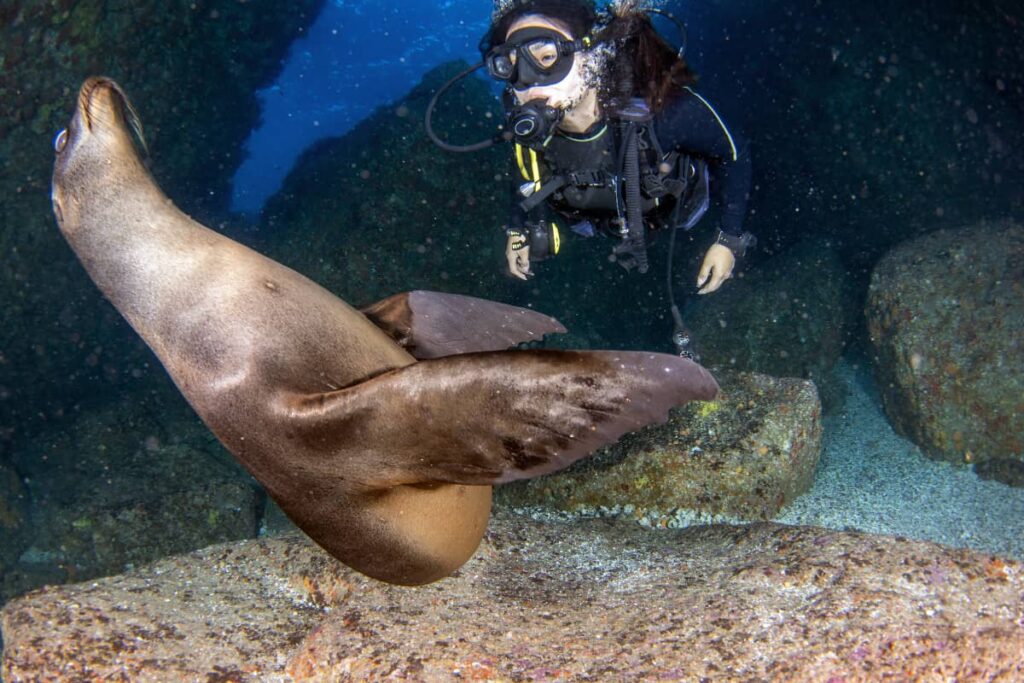
Iconic Dive Sites in the Galapagos
The Galapagos Islands are a UNESCO-protected diving paradise, offering encounters with sharks, rays, and marine life found nowhere else. Liveaboards unlock access to these legendary sites:
- Gordon Rocks: Located off Santa Cruz, this volcanic crater nicknamed “The Washing Machine” thrills advanced divers (30+ dives required) with swirling currents, hammerhead schools, and eagle rays.
- Cousins Rock: A tiny islet north of Santiago Island, famous for black coral gardens, manta ray sightings, and shallow reefs bustling with sea lions—perfect for underwater photographers.
- Wolf Island: Situated in the northern archipelago, its dramatic sites like The Landslide draw schools of scalloped hammerheads, seasonal whale sharks (June–November), and patrolling Galapagos sharks. Learn about other great dives near Wolf Island here.
- Darwin’s Pillars (Darwin Island): A legendary northern site near Darwin Island, where strong currents attract hammerhead sharks, silky sharks, and massive tuna to its underwater cliffs. Learn about other great dives near Darwin Island here.
- Cabo Douglas: Found near Fernandina Island, this unique site lets divers snorkel or dive alongside marine iguanas feeding underwater, with Galapagos penguins darting through cold upwellings.
- Punta Vicente Roca: On Isabela Island’s coast, this cove teems with Mola mola, red-lipped batfish, and octopus hiding in lava tunnels.
- Roca Redonda: Off Isabela Island, volcanic seeps create “Champagne bubbles” amid steep walls frequented by reef sharks, turtles, and barracuda schools.
- Bartolomé’s Pinnacle Rock: Recognizable by its spear-like silhouette, this site near Bartolomé Island hosts Galapagos penguins, white-tipped reef sharks, and eagle rays weaving through lava formations.
- León Dormido (Kicker Rock): A split volcanic tuff cone near San Cristóbal Island, ideal for drift dives with hammerheads, sea turtles, and golden rays gliding through its narrow channel.
- Devil’s Crown: A submerged volcanic crater off Floreana Island, sheltering vibrant coral gardens, reef sharks, and swirling schools of tropical fish in calm, shallow waters.
Note: these are only some of the sites that you may access on your cruise. Contact us for more details and check out our cruises page!
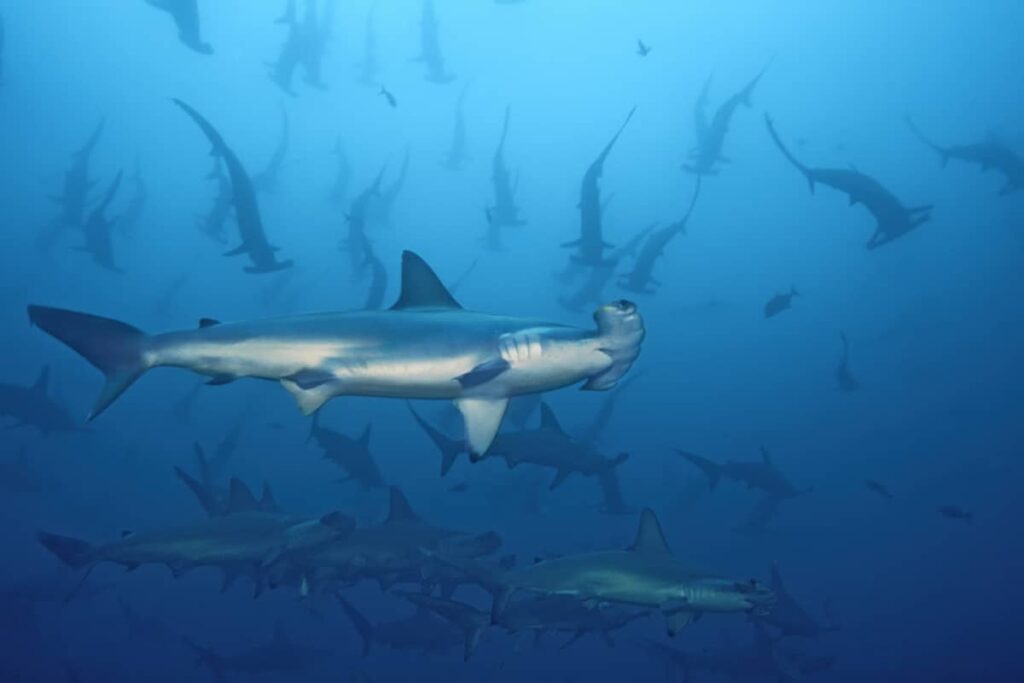
Marine Life Encounters
The Galapagos Archipelago’s UNESCO-protected waters host one of Earth’s most unique marine ecosystems. Liveaboard diving cruises immerse you in a world of endemic and migratory species thriving in nutrient-rich currents. Here is a list of just some of the species you can encounter.
- Scalloped Hammerhead Shark (Sphyrna lewini)
Schools of hundreds patrol Wolf and Darwin Islands, drawn by strong currents and abundant prey. - Oceanic Manta Ray (Mobula birostris)
Glide gracefully through sites like Cousins Rock, often spotted cleaning at coral-covered outcrops. - Marine Iguana (Amblyrhynchus cristatus)
The world’s only ocean-going iguana, seen diving for algae near Fernandina and Isabela Islands. - Galapagos Sea Lion (Zalophus wollebaeki)
Playful and curious, they twirl around divers at shallow reefs like Mosquera and Bartolomé. - Whale Shark (Rhincodon typus)
Gentle giants (June–November) frequent Wolf and Darwin, often swimming alongside hammerheads. - Ocean Sunfish (Mola mola)
Oddly shaped giants feed on jellyfish in colder months (July–December) at Punta Vicente Roca. - Galapagos Shark (Carcharhinus galapagensis)
Bold reef predators circling rocky outcrops like Gordon Rocks and Roca Redonda. - White-tip Reef Shark (Triaenodon obesus)
Nocturnal hunters resting in lava crevices by day, common at Devil’s Crown and Cabo Douglas. - Green Sea Turtle (Chelonia mydas)
Graze on seagrass in sheltered bays like Turtle Cove or drift with currents at Kicker Rock. - Galapagos Penguin (Spheniscus mendiculus)
The equator’s only penguin, darting through Bartolomé’s waters in pursuit of sardines. - Bottlenose Dolphin (Tursiops truncatus)
Pods ride bow waves of liveaboards and hunt alongside sharks in open waters. - Eagle Ray (Aetobatus laticeps)
Solo or in groups, they flap wings-like fins over sandy bottoms near North Seymour. - Red-lipped Batfish (Ogcocephalus darwini)
Quirky bottom-dwellers “walking” on fins, found on volcanic slopes off Isabela. - Barracuda (Sphyraena idiastes)
Silvery hunters form tornado-like schools at Darwin’s Arch and deeper drop-offs. - Pacific Seahorse (Hippocampus ingens)
Camouflaged in algae or coral at sheltered sites like Puerto Egas and Tagus Cove.
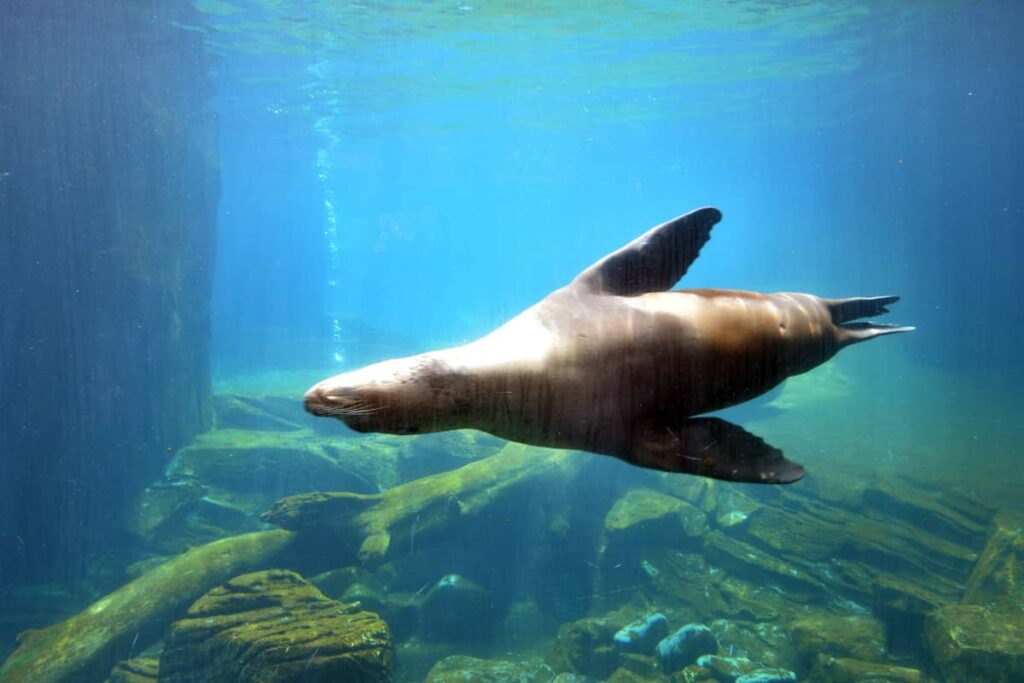
Best Times to Visit the Galapagos for Liveaboard Diving Cruises
The Galapagos Islands offer year-round diving opportunities, but conditions and marine life vary dramatically between seasons. Below is a breakdown of the two primary diving seasons, including weather patterns, marine life highlights, and diving conditions:
1. Cool & Dry Season (June–November)
Weather & Water Conditions
- Air Temperature: 68–80°F (20–27°C), with cooler, overcast skies and occasional fog.
- Water Temperature: 66–77°F (19–25°C), influenced by the nutrient-rich Humboldt Current.
- Visibility: 15–30 meters (50–100 feet), though plankton blooms can reduce clarity.
- Seas: Choppier due to stronger trade winds, requiring sturdy liveaboard vessels.
Marine Life Highlights
- Whale Sharks: Peak sightings from June–November, especially near Wolf and Darwin Islands.
- Hammerhead Sharks: Massive schools congregate at northern dive sites like Darwin’s Arch.
- Galapagos Sharks & Pelagic Species: Frequent encounters with silky sharks, tuna, and dolphins.
- Mola Mola: Cold-water upwellings attract ocean sunfish from July–December.
Diving Conditions
- Currents: Strong, fast-moving currents ideal for drift dives (advanced divers only).
- Gear: A 5–7mm wetsuit, hood, and gloves are recommended for colder thermoclines. Some divers even prefer dry suits! See more in our Tips for a Seamless Experience section
- Prime Sites: Wolf Island, Darwin’s Arch, and Cabo Douglas for shark action.

2. Warm & Wet Season (December–May)
Weather & Water Conditions
- Air Temperature: 75–90°F (24–32°C), with humid, sunny days and brief tropical showers.
- Water Temperature: 70–80°F (21–27°C), warmed by the Panama Current.
- Visibility: 9–18 meters (30–60 feet), with calmer seas and smoother sailing.
- Rainfall: Short afternoon rains rejuvenate terrestrial ecosystems.
Marine Life Highlights
- Manta Rays: Abundant from March–May, often seen cleaning at Cousins Rock.
- Sea Turtles: Green and hawksbill turtles nest on beaches, with hatchlings emerging January–April.
- Hammerhead Sharks: Smaller schools compared to the dry season, but still present..
- Playful Sea Lions: Juveniles interact with divers at sites like Mosquera and Bartolomé.
Diving Conditions
- Currents: Moderate, suitable for intermediate divers.
- Gear: A 3–5mm wetsuit suffices for warmer waters.
- Prime Sites: Gordon Rocks, León Dormido (Kicker Rock), and Punta Vicente Roca for macro life
Our Tips:
- Book Early: June–November liveaboards fill quickly due to whale shark demand.
- Wildlife Trade-Offs: Dry season = big pelagics; wet season = calmer dives and nesting turtles.
Year-Round Perks: Marine iguanas, penguins, and reef sharks are present regardless of season
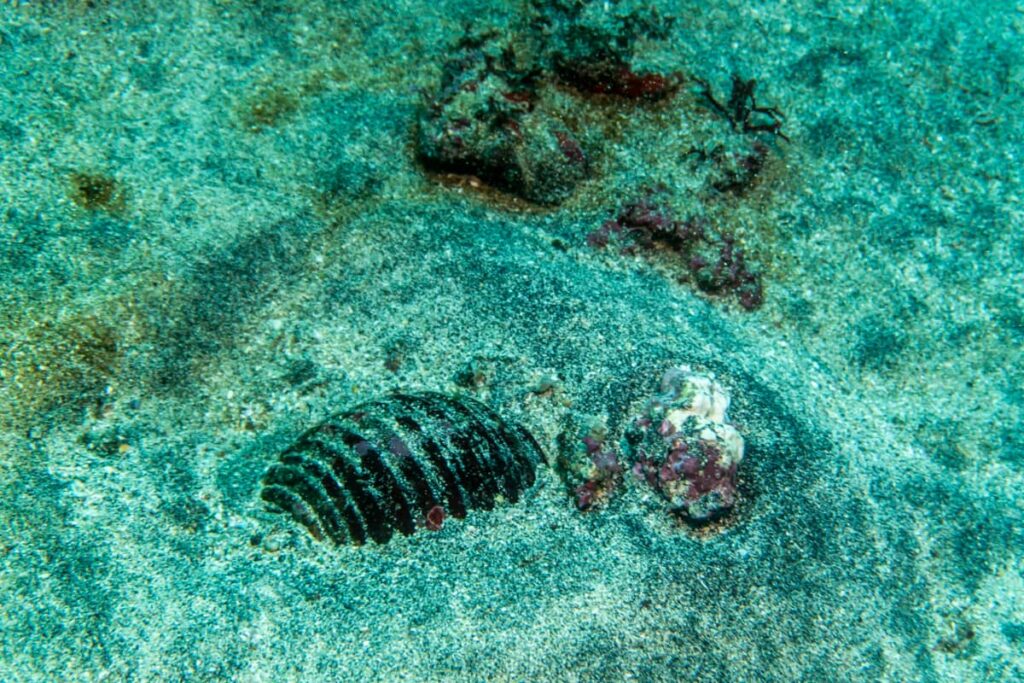
Tips for a Seamless Galapagos Liveaboard Diving Experience
Maximize safety, comfort, and environmental responsibility with these essential tips:
Certifications & Experience
- Confirm Advanced Open Water certification and 30+ logged dives—mandatory for most liveaboards due to strong currents and challenging conditions. 50+ logged dives are recommended as well as experience in cold water and strong currents.
- Consider a Drift Diving Specialty certification to handle Galapagos’ notorious currents confidently.
Gear Essentials
- 7mm wetsuit + hood + gloves: Cold Humboldt Currents (Jun–Nov) demand thermal protection; even in warmer months (Dec–May), a 5mm suit is advised. Some divers bring drysuits to combat the cold ocean water.
- Reef hook + gloves: Navigate barnacle-covered rocks and steady yourself in strong currents.
- Adjust weights: Salinity here is 6% higher than average—test buoyancy during check dives.
- Dive computer + SMB (Surface Marker Buoy): Track dive profiles and stay visible to boats in unpredictable currents.
Note: Many operators offer rental gear, but it's recommended to bring your own mask, fins, gloves, booties, hood, and dive computer if possible, especially for comfort and fit.
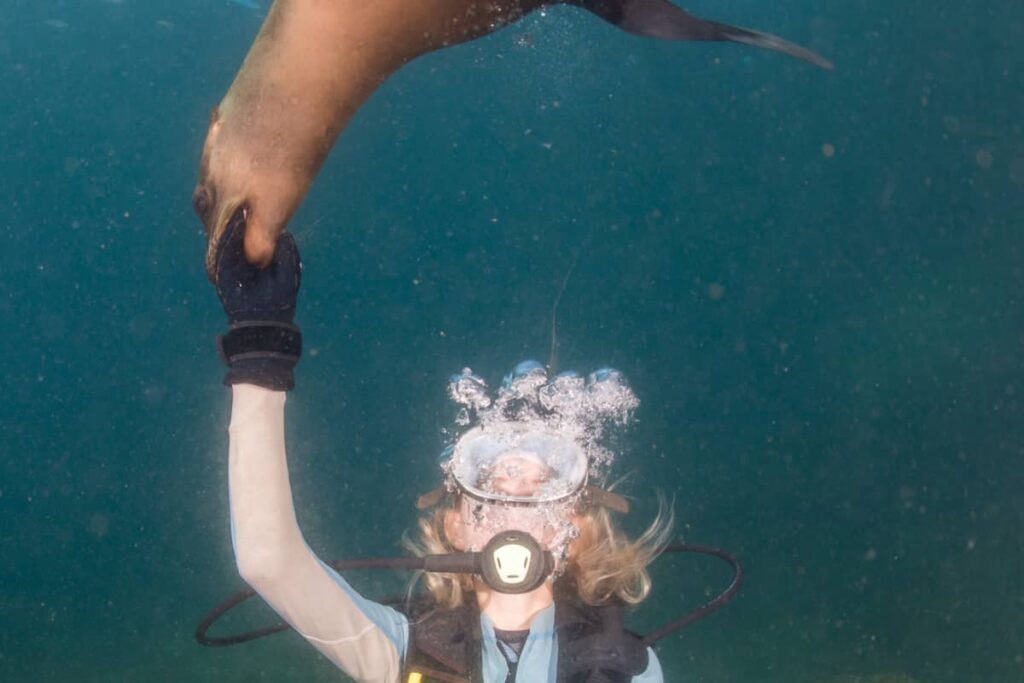
Camera & Tech Prep
- Extra memory cards + batteries: Capture hammerheads, whale sharks, and marine iguanas without missing a shot.
- Red filter for GoPro: Enhances colors in deeper, plankton-rich waters.
Health & Safety
- Seasickness medication: Use Scopolamine patches or Dramamine—choppy seas are common, especially June–November.
- Ear drops + decongestants: Prevent infections from frequent diving; rinse ears post-dive.
- Travel insurance: Ensure coverage for dive-related emergencies.
Logistics & Conservation
- Book 6–12 months early: Prime June–November slots for whale sharks and hammerheads sell out fast.
- Pack light + eco-friendly: Biodegradable toiletries and reef-safe sunscreen protect fragile ecosystems.
- Dry bag + quick-dry towel: Keep gear dry on boats and stay comfortable between dives.
Fitness & Mindset
- Build stamina: Expect 3–4 dives daily; practice buoyancy control in currents beforehand.
- Respect marine life: Avoid touching animals or disturbing habitats—maintain a 2m distance from wildlife.
Pro Tip: Some liveaboards like offer Nitrox (for extended bottom time) and camera rinse tanks—confirm amenities when booking
Dive into the Unforgettable with Galapagos Pronto!
Ready to explore hammerhead highways, swim with whale sharks, and witness marine iguanas in the wild? Let Galapagos Pronto craft your dream liveaboard adventure in the waters of the Galapagos. With expert guides, tailored itineraries, and a commitment to conservation, we turn bucket-list dives into reality.

